
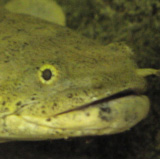
Living Fossils - Keeping Polypterus in the Aquarium
An edited version of this article was originally published in the Christmas 2003 issue of Practical Fishkeeping magazine.
Introduction
"If I had discovered only this species in Egypt, it would compensate me for the pains usually involved in a long journey." These were the words of E. Goeffroy Saint Hilaire of the natural history museum in Paris, upon his discovery of Polypterus, around two centuries ago. The French scholar of natural history, Cuvier, is said to have commented later to the effect of "The invasion of Egypt was worthwhile if only for the discovery of these fishes". Fitting tributes to these fascinating ancient fishes I think!
The origins of the Polypteriforms date back to the Cretaceous period and the time of the dinosaurs, more than 60 million years ago. The present Polypteridae all originate from the freshwaters of Africa. The family is composed of two genera. The first, Erpetoichthys, contains only one species - E. calabaricus, otherwise known as the Rope fish or Reed Fish. The second genus, Polypterus (poll-it-er-us; the second 'p' is silent), contains more than a dozen species (see table below).
The name "Polypterus" translates as "many fins", referring to one of their most obvious features – the multiple dorsal finlets along their back. Other notable features include a snake-like body with large pectoral fins, which are used for locomotion and give the Polypterus a very distinctive method of swimming. The tail is used when a burst of speed is needed. The Polypterus share certain features with other similarly ancient fish: the tough ganoid scales also found on gars and the externally protruding nostrils of the bowfin (Amia calva). The Polypterus also possess a modified swim bladder - a lung-like structure split horizontally into two sections. This enables them to take supplementary gulps of air from the surface – a useful adaptation in water with a low oxygen content.
A few of the Polypterus species (or bichirs as they are commonly known) find their way quite regularly into the aquarium trade. These include P. delhezi, P. ornatipinnis, P. palmas, and P. senegalus. Other species are less commonly encountered. Of the commonly available ones, P. ornatipinnis, the Ornate bichir, is considered particularly striking. P. palmas and senegalus are usually widely available and inexpensive.
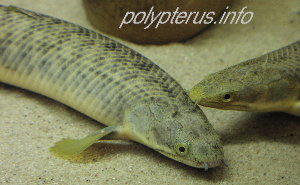
Polypterus polli is one of the
more commonly available species.
Keeping Polypterus in the home aquarium is not particularly difficult, if, as with any fish, their needs are catered for. They should not be kept with overly aggressive fish, such as large cichlids or snakeheads. Suitable tankmates could include Knifefish, Siamese Tigerfish, large barbs such as Tinfoils and medium-sized catfish (note that some suckermouth catfish may harass Polypterus by trying to suck on their bodies). They can usually be kept with any non-aggressive fish that are too large to swallow, as they do not show aggressive behaviour towards other species. However, I have noted that on rare occasions, a Polypterus may bite a larger fish – this is probably a mistaken attempt at snatching a meal, due to their poor eyesight.
Polypterus rely mainly on smell to sense the presence of food in the water, and will usually emerge from their resting-place when food is placed in the tank. They will then meander in the general direction of the food until they virtually bump into it. At times, they may pass over the food, and then slowly retreat to retrieve it, having sensed something they missed.
Although they are sometimes described as “voracious predators” or similar, Polypterus are largely opportunist feeders. That is not to say that they will not eat smaller fish given the opportunity! Their slow movement and poor eyesight might lead one to believe that they would be incapable of catching midwater fish, but they can move remarkably quickly when necessary. Small fish would be in the greatest danger when resting near the bottom at night, when the Polypterus are most active.
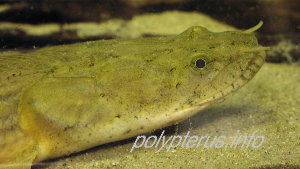
Polypterus congicus -
the largest of the Polypterus.
Polypterus will eat a variety of foods, which should include meaty foods such as cockle, mussel, prawn/shrimp, and baitfish such as whitebait and silversides. They will also consume sinking catfish pellets, and I have observed these “voracious predators” stealing algae wafers intended for catfish… Youngsters can also be fed smaller frozen foods such as bloodworm, and will usually eat sinking granular foods.
Tank set-up
When setting up a tank for Polypterus, or including them in an existing set-up, thought should be given to their potential size. Even the smaller species can be expected to reach 10-12” (25-30cm) in the aquarium, with some species capable of exceeding 24” (60cm). Floor space is more important than the height of the tank, so opt for a shallower tank with a large footprint where possible. For some of the smaller species, a tank with a base 48 x 15” (120 x 38cm) should be suitable. To house the larger species, a 6 x 2’ (180 x 60cm) tank would be more appropriate. As these fish need to be able to reach the surface to snatch a supplementary gulp of air occasionally, deep tanks may actually be less desirable. For this same reason, the tank should never be so full that there is no air gap between the water and the cover. Tight-fitting covers are recommended, as these fish could potentially escape the aquarium – the Rope Fish in particular has a reputation as an escape artist.
The Polypterus are often described as aggressive towards their own and other Polypterus species. Although they will snap at each other, especially over a morsel of food, no obvious damage is usually caused by this behaviour. As long as they are reasonably matched for size, and adequate tank space is provided, you should not encounter any serious aggression problems between them. However, as with most fish, exceptions do occur, and any persistently aggressive individuals should be housed separately.
Given that these fish are primarily bottom feeders, the substrate used in the tank should be something that is easy to keep clean. I prefer a thin layer of soft aquarium sand, though play-pit or horticultural ‘silver sand’ is also suitable. Maintaining them on a smooth gravel substrate might not cause any problems, though I feel this is perhaps less natural for them, and may make feeding more difficult.
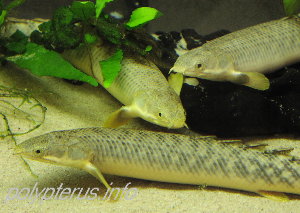
Polypterus polli in an aquarium
furnished with bogwood and plants.
I have seen it suggested that Polypterus be kept in bare tanks, to reduce the chance of territorial behaviour. However, for me, it is a sad sight to see a fish in a bare tank with no décor or place to retreat to. On the other hand, it is a pleasure to watch bichirs slink slowly between the rocks and wood in a more appropriately furnished aquarium. Smooth rocks and larger pieces of bogwood, arranged to make a few caves, will provide suitable décor. Ceramic or plastic tubes can provide a less natural-looking but perfectly suitable alternative. There is also no reason why these fish cannot be kept in a planted tank. They are unlikely to eat or deliberately damage plants, though larger individuals will probably prove ‘clumsy’ in well-planted tanks, in much the same way that larger suckermouth catfish can. Therefore, robust plants, or those that can be easily attached to rocks and wood (such as Java fern and Java moss), are recommended. Some of the more realistic plastic or silk plants that are available could also be used to provide cover.
Filtration can be of any suitable type that ensures plenty of bio-filtration capacity. Although these fish are not overly active or greedy feeders by some standards, the meaty foods they require could pollute the water quickly without adequate filtration. I tend to prefer external canister filters or other types with a high bio-filtration capacity. Any modern heater-stat should be suitable. Use a heater guard where possible, or an external thermofilter, to prevent accidental damage to the heater by these powerful fish.
Care and maintenance
Ideally, these fish should be maintained at the higher end of the tropical temperature range, around 25-28oC (77-82oF). Fairly soft to slightly hard water, with a pH around neutral or slightly acidic is probably ideal, but water chemistry is not critical, as long as the water quality is maintained with frequent water changes. The occurrence of two species of Polypterus in Lake Tanganyika (P. ornatipinnis and P. endlicheri congicus) suggests quite different water chemistries can be adapted to. These fish are considered hardy and very tolerant both of poorer water quality and lower temperatures, but it is not wise to test these limits in the aquarium!
Lighting is not overly important unless you opt for live plants. Being mainly nocturnal, the fish are likely to prefer dim lighting, although juveniles in particular do not appear to be bothered by brighter light at feeding time. It may be worth fitting the tank with one of the blue ‘moonlight’ fluorescent bulbs for an hour or two of evening viewing. Using a timer, this can be set to come on just before the main light goes off, to give a more natural transition to twilight. Increased activity is likely to be observed when the tank is dimly lit, such as from background light in the room.
Polypterus appear to be very hardy fish that rarely suffer from disease. Their tough ganoid scales afford them a degree of protection from the sort of injuries that lead to bacterial or fungal infections, and may also make them more resistant to certain parasites. However, newly imported specimens may be suffering from an infection of a freshwater leech, Macrogyrodactylus polypteri that attaches itself to the body of the fish. The fish may try to seek relief by attempting to scratch itself, behaviour often referred to as “flashing” or “flicking”. Formalin baths are effective in removing this parasite. Observe fish carefully before purchase.
Sexual differences in Polypterus are not immediately obvious, but mature males can be identified by their wider and thicker anal fin. It has also been suggested that they have thicker dorsal spines. Females tend to be larger. There are no clear differences in small juveniles. A number of Polypterus species have been bred in captivity, including P. ornatipinnis, senegalus and endlicheri. However, spawning in the home aquarium is still rare.
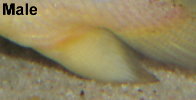
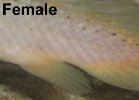
The anal fins of P. s. senegalus
Success is more likely in soft, slightly acidic water. Changes in the temperature and chemistry of the water are likely to be part of the key to inducing spawning. The male cups his anal and caudal fins around the female's genital area to receive eggs for fertilisation, after which the adhesive eggs are scattered. Fine-leaved plants (or spawning mops) should be provided for this. It is generally agreed that the parents and eggs should be separated as soon as possible after spawning, to prevent the eggs (or fry) being eaten. The eggs are about 2-3mm in diameter, and should hatch in about 3-4 days. Feeding should begin after about a week, when the yolk sac has been consumed. Baby brine shrimp (Artemia nauplii) or microworms may prove to be one of the best foods for the new fry, and should be placed as close to the fry as possible, as they are not likely to actively pursue food initially.
Table: The described species of Polypterus (updated)
| Scientific name | Common name(s) | Size | Origin |
|---|---|---|---|
| Polypterus ansorgii | Guinean bichir | 11" (28cm) | West Africa (Guinea) |
| Polypterus bichir | Nile bichir | 27" (68cm) | Nile, Cameroon, Ethiopia, Ghana |
| Polypterus congicus | Congo bichir | 39" (97cm) | Congo, Lake Tanganyika |
| Polypterus delhezi | Armoured / Banded bichir | 14" (35cm) | Central Africa: Congo river, Upper and middle Congo |
| Polypterus endlicheri | Red / Saddled bichir | 24" (60cm) or more | Nigeria, Lake Chad, White Nile |
| Polypterus mokelembembe | Mokele Mbembe bichir | 14" (35cm) | Congo River basin |
| Polypterus ornatipinnis | Ornate bichir | 24" (60cm) | Central and East Africa: Congo river basin, Lake Tanganyika |
| Polypterus palmas | Marbled bichir | 12" (30cm) | Congo, Liberia, Sierra Leone, Guinea |
| Polypterus polli | Poll's bichir | 12" (30cm) | W. & Central Africa, Congo River |
| Polypterus retropinnis | West African / Speckled bichir | 13" (33cm) | West and Central Africa |
| Polypterus senegalus | Senegal bichir | 16" (40cm) | Africa: East, West and central |
| Polypterus teugelsi | 16" (40cm) | Cameroon | |
| Polypterus weeksii | Mottled / Week's / Fat-Headed bichir | 16-24" (40-60cm) | Congo |
Suggested reading:
Jurassic Fishes by Haruto Kodera and others, published by TFH. There is an English edition published in 1996, but this book is becoming difficult to obtain, so if you are a fan of primitive fishes, snap up a copy quickly! The title is a little misleading, but there are several excellent pictures of Polypterus, and a wealth of information on other primitive fishes such as gars, rays and arowanas.
References:
Gosse, J.-P. (1984). Polypteridae. p. 18-29. In: J. Daget, J.-P. Gosse and D.F.E. Thys van den Audenaerde (eds.) Check-list of the freshwater fishes of Africa (CLOFFA). ORSTOM, Paris and MRAC, Tervuren. Vol. 1.
Hanssens, M.M., G.G.Teugels, D.F.E.Thys Van den Audenaerde (1995). Subspecies in the Polypterus palmas complex (Brachiopterygii; Polypteridae) from West and Central Africa. Copeia 1995 (3): 694-705.
Britz, R. & Bartsch, P. (1998): On the reproduction and early development of Erpetoichthys calabaricus, Polypterus senegalus, and P. ornatipinnis (Actinopterygii: Polypteridae). Ichthyological Exploration of Freshwaters 9 (4): 325-334.
Daget, J. , Gayet, M. , Meunier, F.J. and Sire, J-Y. (2001) Major discoveries on the dermal skeleton of fossil and Recent polypteriforms: a review. Fish and Fisheries 2: 113–124
Britz, R. (2004): Polypterus teugelsi, a new species of bichir from the Upper Cross River system in Cameroon (Actinopterygii: Cladistia: Polypteridae). Ichthyological Exploration of Freshwaters 15 (2): 179-186.
Notes on changes to original article:
The photos used here were taken by the author. The article as
published in Practical Fishkeeping used different photos
supplied by an external source. One of these was mislabelled
"Polypterus senegalus and palmas", when
in fact it showed Polypterus senegalus and
endlicheri.
Additional detail on spawning has been
added, and the table above has also been updated with respect to
the more recent publication describing P. teugelsi.
This article Copyright © 2003-2004 Sean Evans. All rights reserved.
